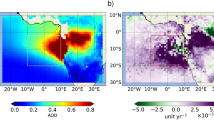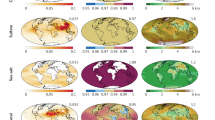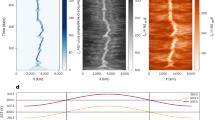Abstract
Atmospheric aerosols are an important component of the Earth’s climate system and contribute substantial uncertainties to predictions of future climate change. In the southeast Atlantic, where expansive light-absorbing smoke aerosol plumes overlie semi-permanent stratocumulus clouds, the direct aerosol radiative effect (DARE) induces warming, but the magnitude of this effect varies widely among climate models. Thus, it is essential to improve estimates based on observations to help constrain model uncertainties. However, the impact of the observed cloud diurnal cycle on DARE remains unclear. Here we quantify DARE using radiative transfer modelling based on hourly satellite observations of clouds focusing on the region 20° S–0° and 10° W–15° E. We find that accounting for the observed cloud diurnal cycle over the southeast Atlantic, rather than assuming a constant early-afternoon cloud field throughout the entire day, results in a more than twofold increase (+1.7 ± 0.4 W m−2) in the regional mean aerosol radiative warming. The increase in DARE results from morning hours when cloud fractions and optical depths are higher. Neglect of the cloud diurnal cycle adds to the underestimated radiative warming in the southeast Atlantic associated with underestimated aerosol absorption among climate models. Future observations-based estimates of aerosol climatic effects need to account for the cloud diurnal cycle.
This is a preview of subscription content, access via your institution
Access options
Access Nature and 54 other Nature Portfolio journals
Get Nature+, our best-value online-access subscription
$32.99 / 30 days
cancel any time
Subscribe to this journal
Receive 12 print issues and online access
$259.00 per year
only $21.58 per issue
Buy this article
- Purchase on SpringerLink
- Instant access to full article PDF
Prices may be subject to local taxes which are calculated during checkout





Similar content being viewed by others
Data availability
The VIIRS satellite images were adapted from NASA Worldview (https://worldview.earthdata.nasa.gov/). The SEVIRI cloud data are available from NASA SatCORPS at https://satcorps.larc.nasa.gov/. The MERRA-2 data are available from NASA GES DISC at https://disc.gsfc.nasa.gov/datasets/M2I3NVAER_5.12.4/summary. The processed data used to present the results in this Article are available via Zenodo at https://doi.org/10.5281/zenodo.15540263 (ref. 60).
Code availability
The codes used to generate figures in this publication are available via Zenodo at https://doi.org/10.5281/zenodo.15540263 (ref. 60).
References
Ramanathan, V., Crutzen, P. J., Kiehl, J. T. & Rosenfeld, D. Aerosols, climate, and the hydrological cycle. Science 294, 2119–2124 (2001).
Hansen, J. et al. Efficacy of climate forcings. J. Geophys. Res. 110, D18104 (2005).
Isaksen, I. S. A. et al. Atmospheric composition change: climate–chemistry interactions. Atmos. Environ. 43, 5138–5192 (2009).
Bellouin, N. et al. Bounding global aerosol radiative forcing of climate change. Rev. Geophys. https://doi.org/10.1029/2019rg000660 (2020).
McCormick, R. A. & Ludwig, J. H. Climate modification by atmospheric aerosols. Science 156, 1358–1359 (1967).
Wood, R. & Hartmann, D. L. Spatial variability of liquid water path in marine low cloud: the importance of mesoscale cellular convection. J. Clim. 19, 1748–1764 (2006).
Twomey, S. Pollution and the planetary albedo. Atmos. Environ. 8, 1251–1256 (1974).
Twomey, S. The influence of pollution on the shortwave albedo of clouds. J. Atmos. Sci. 34, 1149–1152 (1977).
Yu, H. et al. A review of measurement-based assessments of the aerosol direct radiative effect and forcing. Atmos. Chem. Phys. 6, 613–666 (2006).
Myhre, G. et al. Comparison of the radiative properties and direct radiative effect of aerosols from a global aerosol model and remote sensing data over ocean. Tellus B 59, 115–129 (2007).
Su, W., Loeb, N. G., Schuster, G. L., Chin, M. & Rose, F. G. Global all-sky shortwave direct radiative forcing of anthropogenic aerosols from combined satellite observations and GOCART simulations. J. Geophys. Res. Atmos. 118, 655–669 (2013).
Zhang, Z. et al. Shortwave direct radiative effects of above-cloud aerosols over global oceans derived from 8 years of CALIOP and MODIS observations. Atmos. Chem. Phys. 16, 2877–2900 (2016).
Oikawa, E., Nakajima, T. & Winker, D. An evaluation of the shortwave direct aerosol radiative forcing using CALIOP and MODIS observations. J. Geophys. Res. Atmos. 123, 1211–1233 (2018).
Kacenelenbogen, M. S. et al. Estimations of global shortwave direct aerosol radiative effects above opaque water clouds using a combination of A-Train satellite sensors. Atmos. Chem. Phys. 19, 4933–4962 (2019).
Forster, P. et al. in Climate Change 2021: The Physical Science Basis (eds Masson-Delmotte, V. et al.) 923–1054 (IPCC, Cambridge Univ. Press, 2023).
Haywood, J. M. et al. The CLoud–Aerosol–Radiation Interaction and Forcing: Year 2017 (CLARIFY-2017) measurement campaign. Atmos. Chem. Phys. 21, 1049–1084 (2021).
Oikawa, E., Nakajima, T., Inoue, T. & Winker, D. A study of the shortwave direct aerosol forcing using ESSP/CALIPSO observation and GCM simulation. J. Geophys. Res. Atmos. 118, 3687–3708 (2013).
Zhang, Z. et al. A novel method for estimating shortwave direct radiative effect of above-cloud aerosols using CALIOP and MODIS data. Atmos. Meas. Tech. 7, 1777–1789 (2014).
Matus, A. V., L’Ecuyer, T. S., Kay, J. E., Hannay, C. & Lamarque, J.-F. The role of clouds in modulating global aerosol direct radiative effects in spaceborne active observations and the Community Earth System Model. J. Clim. 28, 2986–3003 (2015).
Lacagnina, C., Hasekamp, O. P. & Torres, O. Direct radiative effect of aerosols based on PARASOL and OMI satellite observations. J. Geophys. Res. Atmos. 122, 2366–2388 (2017).
Matus, A. V., L’Ecuyer, T. S. & Henderson, D. S. New estimates of aerosol direct radiative effects and forcing from A‐Train satellite observations. Geophys. Res. Lett. 46, 8338–8346 (2019).
de Graaf, M. et al. Comparison of south-east Atlantic aerosol direct radiative effect over clouds from SCIAMACHY, POLDER and OMI–MODIS. Atmos. Chem. Phys. 20, 6707–6723 (2020).
Thorsen, T. J., Ferrare, R. A., Kato, S. & Winker, D. M. Aerosol direct radiative effect sensitivity analysis. J. Clim. 33, 6119–6139 (2020).
Min, M. & Zhang, Z. On the influence of cloud fraction diurnal cycle and sub-grid cloud optical thickness variability on all-sky direct aerosol radiative forcing. J. Quant. Spectrosc. Radiat. Transf. 142, 25–36 (2014).
Adebiyi, A. A., Zuidema, P. & Abel, S. J. The convolution of dynamics and moisture with the presence of shortwave absorbing aerosols over the southeast Atlantic. J. Climate 28, 1997–2024 (2015).
Chang, I. et al. On the differences in the vertical distribution of modeled aerosol optical depth over the southeastern Atlantic. Atmos. Chem. Phys. 23, 4283–4309 (2023).
Zuidema, P. et al. Smoke and clouds above the southeast Atlantic: upcoming field campaigns probe absorbing aerosol’s impact on climate. Bull. Am. Meteorol. Soc. 97, 1131–1135 (2016).
Formenti, P. et al. The aerosols, radiation and clouds in southern Africa field campaign in Namibia: overview, illustrative observations, and way forward. Bull. Am. Meteorol. Soc. 100, 1277–1298 (2019).
Redemann, J. et al. An overview of the ORACLES (ObseRvations of Aerosols above CLouds and their intEractionS) project: aerosol–cloud–radiation interactions in the southeast Atlantic basin. Atmos. Chem. Phys. 21, 1507–1563 (2021).
Jethva, H., Torres, O., Remer, L. A. & Bhartia, P. K. A color ratio method for simultaneous retrieval of aerosol and cloud optical thickness of above-cloud absorbing aerosols from passive sensors: application to MODIS measurements. IEEE Trans. Geosci. Remote Sens. 51, 3862–3870 (2013).
Jethva, H., Torres, O., Waquet, F., Chand, D. & Hu, Y. How do A-train sensors intercompare in the retrieval of above-cloud aerosol optical depth? A case study-based assessment. Geophys. Res. Lett. 41, 2013GL058405 (2014).
Chang, I. & Christopher, S. A. Identifying absorbing aerosols above clouds from the Spinning Enhanced Visible and Infrared Imager coupled with NASA A-Train multiple sensors. IEEE Trans. Geosci. Remote Sens. 54, 3163–3173 (2016).
Chang, I. et al. Spatiotemporal heterogeneity of aerosol and cloud properties over the southeast Atlantic: an observational analysis. Geophys. Res. Lett. https://doi.org/10.1029/2020GL091469 (2021).
Chand, D., Wood, R., Anderson, T. L., Satheesh, S. K. & Charlson, R. J. Satellite-derived direct radiative effect of aerosols dependent on cloud cover. Nat. Geosci 2, 181–184 (2009).
Chýlek, P., Grams, G. W., Smith, G. A. & Russell, P. B. Hemispherical backscattering by aerosols. J. Appl. Meteorol. 14, 380–387 (1975).
Jethva, H., Torres, O. & Ahn, C. A 12-year long global record of optical depth of absorbing aerosols above the clouds derived from the OMI/OMACA algorithm. Atmos. Meas. Tech. 11, 5837–5864 (2018).
Haywood, J. M. & Shine, K. P. Multi-spectral calculations of the direct radiative forcing of tropospheric sulphate and soot aerosols using a column model. Q. J. R. Meteorol. Soc. 123, 1907–1930 (1997).
Boucher, O. On aerosol direct shortwave forcing and the Henyey–Greenstein phase function. J. Atmos. Sci. 55, 128–134 (1998).
Turton, J. D. & Nicholls, S. A study of the diurnal variation of stratocumulus using a multiple mixed layer model. Q. J. R. Meteorol. Soc. 113, 969–1009 (1987).
Rogers, D. P. & Korac̆in, D. Radiative transfer and turbulence in the cloud-topped marine atmospheric boundary layer. J. Atmos. Sci. 49, 1473–1486 (1992).
Formenti, P. et al. STAAARTE‐MED 1998 summer airborne measurements over the Aegean Sea 2. Aerosol scattering and absorption, and radiative calculations. J. Geophys. Res. https://doi.org/10.1029/2001JD001536 (2002).
Ryoo, J.-M. et al. A meteorological overview of the ORACLES (ObseRvations of Aerosols above CLouds and their intEractionS) campaign over the southeastern Atlantic during 2016–2018: part 1 – climatology. Atmos. Chem. Phys. 21, 16689–16707 (2021).
Chang, I. & Christopher, S. A. The impact of seasonalities on direct radiative effects and radiative heating rates of absorbing aerosols above clouds. Q. J. R. Meteorol. Soc. 143, 1395–1405 (2017).
Thorsen, T. J., Winker, D. M. & Ferrare, R. A. Uncertainty in observational estimates of the aerosol direct radiative effect and forcing. J. Clim. 34, 195–214 (2021).
Dubovik, O. et al. Accuracy assessments of aerosol optical properties retrieved from Aerosol Robotic Network (AERONET) Sun and sky radiance measurements. J. Geophys. Res. 105, 9791–9806 (2000).
Devi, A. & Satheesh, S. K. Global maps of aerosol single scattering albedo using combined CERES-MODIS retrieval. Atmos. Chem. Phys. 22, 5365–5376 (2022).
Kaufman, Y. J., Koren, I., Remer, L. A., Rosenfeld, D. & Rudich, Y. The effect of smoke, dust, and pollution aerosol on shallow cloud development over the Atlantic Ocean. Proc. Natl Acad. Sci. USA 102, 11207–11212 (2005).
Zhang, J. & Zuidema, P. The diurnal cycle of the smoky marine boundary layer observed during August in the remote southeast Atlantic. Atmos. Chem. Phys. 19, 14493–14516 (2019).
Mallet, M. et al. Climate models generally underrepresent the warming by Central Africa biomass-burning aerosols over the Southeast Atlantic. Sci. Adv. 7, eabg9998 (2021).
Sun, E. et al. Variation in MERRA-2 aerosol optical depth and absorption aerosol optical depth over China from 1980 to 2017. J. Atmos. Sol. Terr. Phys. 186, 8–19 (2019).
Gelaro, R. et al. The Modern-Era Retrospective Analysis for Research and Applications, Version 2 (MERRA-2). J. Clim. 30, 5419–5454 (2017).
Buchard, V. et al. The MERRA-2 aerosol eeanalysis, 1980 onward. Part II: evaluation and case studies. J. Clim. 30, 6851–6872 (2017).
Randles, C. A. et al. The MERRA-2 aerosol reanalysis, 1980 onward. Part I: system description and data assimilation evaluation. J. Climate 30, 6823–6850 (2017).
Doelling, D., Haney, C., Bhatt, R., Scarino, B. & Gopalan, A. Geostationary visible imager calibration for the CERES SYN1deg edition 4 product. Remote Sensing 10, 288 (2018).
Minnis, P. et al. CERES Edition-2 cloud property retrievals using TRMM VIRS and Terra and Aqua MODIS Data—part I: algorithms. IEEE Trans. Geosci. Remote Sensing 49, 4374–4400 (2011).
Emde, C. et al. The libRadtran software package for radiative transfer calculations (version 2.0.1). Geosci. Model Dev. 9, 1647–1672 (2016).
Mayer, B. & Kylling, A. Technical note: the libRadtran software package for radiative transfer calculations – description and examples of use. Atmos. Chem. Phys. 5, 1855–1877 (2005).
Fu, Q. & Liou, K. N. On the correlated k-distribution method for radiative transfer in nonhomogeneous atmospheres. J. Atmos. Sci. 49, 2139–2156 (1992).
Platnick, S. et al. The MODIS cloud optical and microphysical products: collection 6 updates and examples from Terra and Aqua. IEEE Trans. Geosci. Remote Sensing 55, 502–525 (2017).
Chang, I. Regional aerosol warming enhanced by the diurnal cycle of low cloud. Zenodo https://doi.org/10.5281/zenodo.15540263 (2025).
Acknowledgements
This research has been supported by the University of North Carolina at Charlotte start-up package (grant no. 134033) and the University of Oklahoma (OU) start-up package (grant no. 122007900). Part of the computation in this Article was performed at the Supercomputing Center for Education & Research (OSCER) at the University of Oklahoma (OU). D.P. and W.S. acknowledge support from NASA’s Atmospheric Composition Campaign Data Analysis and Modeling and Clouds and the Earth’s Radiant Energy System (CERES) programmes. P.Z. acknowledges support from NASA grant no. 80NSSC21K1344 and DOE ASR grant no. DE-SC002125. The contribution of S.J.D. to this publication is partially funded by the Cooperative Institute for Climate, Ocean, & Ecosystem Studies (CICOES) under NOAA Cooperative Agreement NA20OAR4320271, Contribution No. 2025-1458.
Author information
Authors and Affiliations
Contributions
I.C. and J.R. conceived the study. I.C., D.P. and Z.Z. developed the methodology. I.C. and L.G. performed the radiative transfer calculations. I.C., L.G., D.P., W.L.S. Jr, E.D.L., J.Z. and Z.Y. analysed the SEVIRI cloud data. A.A.F., P.C. and A.M.d.S. analysed the MERRA-2 data. All authors reviewed and edited the Article.
Corresponding author
Ethics declarations
Competing interests
The authors declare no competing interests.
Peer review
Peer review information
Nature Geoscience thanks the anonymous reviewer(s) for their contribution to the peer review of this work. Primary Handling Editor: Thomas Richardson, in collaboration with the Nature Geoscience team.
Additional information
Publisher’s note Springer Nature remains neutral with regard to jurisdictional claims in published maps and institutional affiliations.
Extended data
Extended Data Fig. 1 Monthly mean diurnal cycles of DARESurface.
a–c. DARESurface for hourly varying cloud properties with those based on diurnally fixed cloud properties from 1300 UTC throughout the day during 2016–2018 for August (a), September (b), and October (c). The filled circles represent DARE based on hourly varying COD and CF and three-hourly variations of the aerosol optical depth. The dashed lines denote DARE using diurnally fixed cloud and aerosol properties. The monthly mean DARE values are summarized in Extended Data Table 1.
Extended Data Fig. 2 Monthly mean diurnal cycles of DAREATM.
a–c. DAREATM for hourly varying cloud properties with those based on diurnally fixed cloud properties from 1300 UTC throughout the day during 2016–2018 for August (a), September (b), and October (c). The filled circles represent DARE based on hourly varying COD and CF and three-hourly variations of the aerosol optical depth. The dashed lines denote DARE using diurnally fixed cloud and aerosol properties. The monthly mean DARE values are summarized in Extended Data Table 1.
Extended Data Fig. 3 The twenty monthly mean aerosol models over the southeast Atlantic.
Each of the twenty numbered grids spans over 10° × 10° with a unique set of aerosol SSA and asymmetry parameter for COD corrections and flux calculations.
Extended Data Fig. 4 Monthly mean differences in DARESurface between hourly varying and diurnally fixed cloud properties.
Same as Fig. 5, but for the surface.
Supplementary information
Supplementary Information
Supplementary Figs. 1 and 2.
Rights and permissions
Springer Nature or its licensor (e.g. a society or other partner) holds exclusive rights to this article under a publishing agreement with the author(s) or other rightsholder(s); author self-archiving of the accepted manuscript version of this article is solely governed by the terms of such publishing agreement and applicable law.
About this article
Cite this article
Chang, I., Gao, L., Adebiyi, A.A. et al. Regional aerosol warming enhanced by the diurnal cycle of low cloud. Nat. Geosci. 18, 702–708 (2025). https://doi.org/10.1038/s41561-025-01740-1
Received:
Accepted:
Published:
Issue date:
DOI: https://doi.org/10.1038/s41561-025-01740-1



